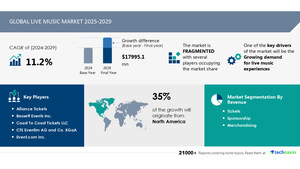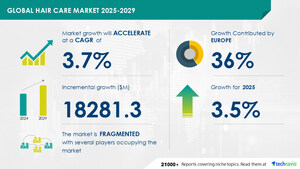NEW YORK, June 19, 2024 /PRNewswire/ -- The global atopic dermatitis drugs market size is estimated to grow by USD 6.20 billion from 2024-2028, according to Technavio. The market is estimated to grow at a CAGR of 10.87% during the forecast period. High prevalence of atopic dermatitis is driving market growth, with a trend towards strategic partnerships and acquisitions. However, side effects associated with corticosteroids poses a challenge. Key market players include AbbVie Inc., Arcutis Biotherapeutics Inc., Asana BioSciences LLC, Astellas Pharma Inc., Bausch Health Companies Inc., Bayer AG, BiomX Inc., Bristol Myers Squibb Co., Dermavant Sciences Inc., Eli Lilly and Co., Evelo Biosciences Inc., Galderma SA, Incyte Corp., LEO Pharma AS, Maruho Co. Ltd., Novartis AG, Otsuka Holdings Co. Ltd., Pfizer Inc., Sanofi SA, and Viatris Inc..
Get a detailed analysis on regions, market segments, customer landscape, and companies - Click for the snapshot of this report
Forecast period |
2024-2028 |
Base Year |
2023 |
Historic Data |
2018 - 2022 |
Segment Covered |
Route Of Administration (Oral, Topical, and Injectable), Drug Class (Biologics, PDE4 inhibitors, Corticosteroids, and Calcineurin inhibitors), and Geography (North America, Europe, Asia, and Rest of World (ROW)) |
Region Covered |
North America, Europe, Asia, and Rest of World (ROW) |
Key companies profiled |
AbbVie Inc., Arcutis Biotherapeutics Inc., Asana BioSciences LLC, Astellas Pharma Inc., Bausch Health Companies Inc., Bayer AG, BiomX Inc., Bristol Myers Squibb Co., Dermavant Sciences Inc., Eli Lilly and Co., Evelo Biosciences Inc., Galderma SA, Incyte Corp., LEO Pharma AS, Maruho Co. Ltd., Novartis AG, Otsuka Holdings Co. Ltd., Pfizer Inc., Sanofi SA, and Viatris Inc. |
Key Market Trends Fueling Growth
Vendors in the global atopic dermatitis drugs market have expanded their product offerings through strategic initiatives such as mergers and acquisitions and technology collaborations since 2019. For instance, Pfizer and Glenmark's introduction of Abrocitinib, an approved treatment for moderate-to-severe atopic dermatitis, in India and other regions, is a notable example. Such partnerships and approvals contribute to market growth and potential profit margin increases.
The Atopic Dermatitis Drugs Market is experiencing significant growth due to the rising prevalence of atopic dermatitis worldwide. The market consists of various treatments, including topical corticosteroids, calcineurin inhibitors, and biologics. Topical corticosteroids remain the first-line therapy for mild to moderate atopic dermatitis. Calcineurin inhibitors are used for sensitive areas and long-term treatment. Biologics, such as dupilumab, are emerging as effective treatments for severe atopic dermatitis. The market is also witnessing the development of new drugs, like PDE4 inhibitors and JAK inhibitors, which show promising results. The regulatory approval of these new drugs is expected to further boost the market growth. Additionally, the increasing awareness and diagnosis of atopic dermatitis are driving the market demand.
Research report provides comprehensive data on impact of trend. For more details- Download a Sample Report
Market Challenges
• The atopic dermatitis drugs market is challenged by the limited use of corticosteroids due to their potential side effects. These medications, including clobetasol propionate and fluocinonide, effectively reduce itching, inflammation, and redness. However, their long-term use is discouraged due to risks like skin thinning, thickening, and discoloration. Systemic side effects, such as fluid retention, high blood pressure, bone damage, and Cushings Syndrome, further limit their adoption. Patients typically resort to corticosteroids when other skincare regimens fail, but the market growth is hindered by these constraints.
• The Atopic Dermatitis Drugs Market faces several challenges in providing effective treatments. Topical corticosteroids, such as Clobetasone and Dexamethasone, are commonly used for their anti-inflammatory properties. However, long-term use can lead to side effects like thinning of the skin and increased risk of infections. Calcineurin inhibitors, like Tacrolimus and Pimecrolimus, are alternative options, but they can cause burning and itching at the application site. Biologics, like Dupilumab and Eczema, offer promising results but come with higher costs and potential safety concerns. Regulating authorities require rigorous testing and safety measures to ensure patient safety. In addition, patient compliance and adherence to treatment plans remain significant challenges. Overall, the Atopic Dermatitis Drugs Market requires continuous innovation and research to address these challenges and provide effective, safe, and affordable treatment options.
For more insights on driver and challenges - Download a Sample Report
Segment Overview
This atopic dermatitis drugs market report extensively covers market segmentation by
- Route Of Administration
- 1.1 Oral
- 1.2 Topical
- 1.3 Injectable
- Drug Class
- 2.1 Biologics
- 2.2 PDE4 inhibitors
- 2.3 Corticosteroids
- 2.4 Calcineurin inhibitors
- Geography
- 3.1 North America
- 3.2 Europe
- 3.3 Asia
- 3.4 Rest of World (ROW)
1.1 Oral-
For more information on market segmentation with geographical analysis including forecast (2024-2028) and historic data (2018 - 2022) - Download a Sample Report
Research Analysis
The Atopic Dermatitis Drugs Market encompasses a range of treatments for this prevalent inflammatory skin condition. Corticosteroids, including topical forms, have long been a mainstay in managing symptoms. However, regulatory complexities and healthcare access disparities have led to an increased interest in novel treatments. Biologics and targeted therapies, such as Ruxolitinib Cream, are emerging as effective alternatives. The adoption of telemedicine in hospital pharmacies facilitates easier access to these treatments for pediatric patients and adults alike. The disease prevalence, driven by Westernized lifestyles, contributes significantly to healthcare expenditure. Novel products, like Crisaborole ointment, and hand eczema treatments are also gaining traction. Infections and oil stripping soaps can exacerbate Atopic Dermatitis, making the development of effective treatments a priority.
The Atopic Dermatitis Drugs Market encompasses a range of treatments for this chronic and relapsing inflammatory skin condition. These drugs include topical corticosteroids, calcineurin inhibitors, phototherapy, and biologics. Topical corticosteroids are commonly used for mild to moderate atopic dermatitis, while calcineurin inhibitors are preferred for sensitive areas or in cases of steroid resistance. Phototherapy, including UVB and PUVA, is effective for severe cases, but carries the risk of side effects. Biologics, such as dupilumab, are the latest addition to the market, offering a targeted approach to treating atopic dermatitis by inhibiting specific cytokines involved in the inflammatory response. The market for these drugs is expected to grow due to the increasing prevalence of atopic dermatitis and the development of new, more effective treatments.
Table of Contents:
1 Executive Summary
2 Market Landscape
3 Market Sizing
4 Historic Market Size
5 Five Forces Analysis
6 Market Segmentation
- Route Of Administration
- Oral
- Topical
- Injectable
- Drug Class
- Biologics
- PDE4 Inhibitors
- Corticosteroids
- Calcineurin Inhibitors
- Geography
- North America
- Europe
- Asia
- Rest Of World (ROW)
7 Customer Landscape
8 Geographic Landscape
9 Drivers, Challenges, and Trends
10 Company Landscape
11 Company Analysis
12 Appendix
About Technavio
Technavio is a leading global technology research and advisory company. Their research and analysis focuses on emerging market trends and provides actionable insights to help businesses identify market opportunities and develop effective strategies to optimize their market positions.
With over 500 specialized analysts, Technavio's report library consists of more than 17,000 reports and counting, covering 800 technologies, spanning across 50 countries. Their client base consists of enterprises of all sizes, including more than 100 Fortune 500 companies. This growing client base relies on Technavio's comprehensive coverage, extensive research, and actionable market insights to identify opportunities in existing and potential markets and assess their competitive positions within changing market scenarios.
Contacts
Technavio Research
Jesse Maida
Media & Marketing Executive
US: +1 844 364 1100
UK: +44 203 893 3200
Email: [email protected]
Website: www.technavio.com/
SOURCE Technavio

WANT YOUR COMPANY'S NEWS FEATURED ON PRNEWSWIRE.COM?
Newsrooms &
Influencers
Digital Media
Outlets
Journalists
Opted In





Share this article